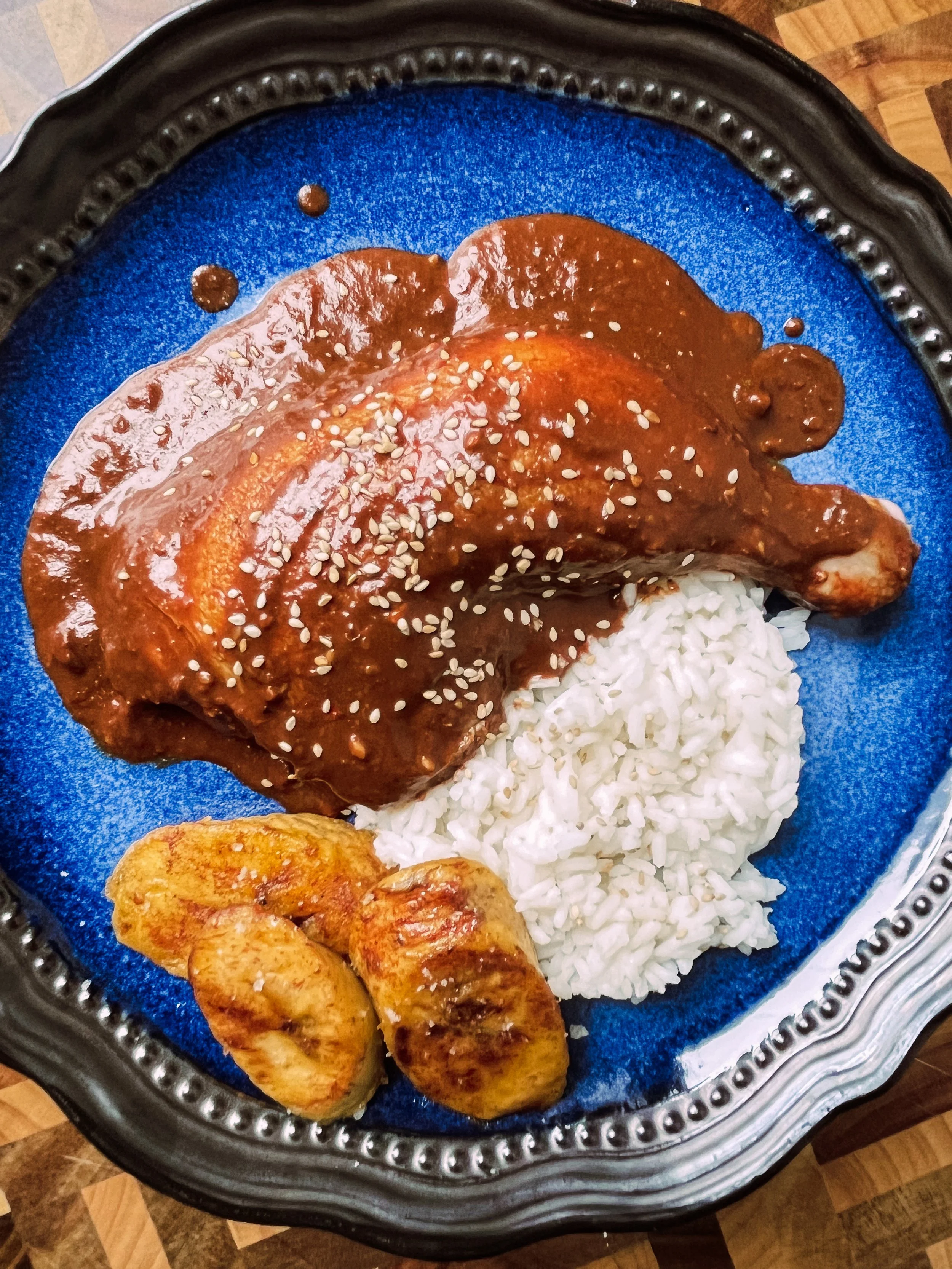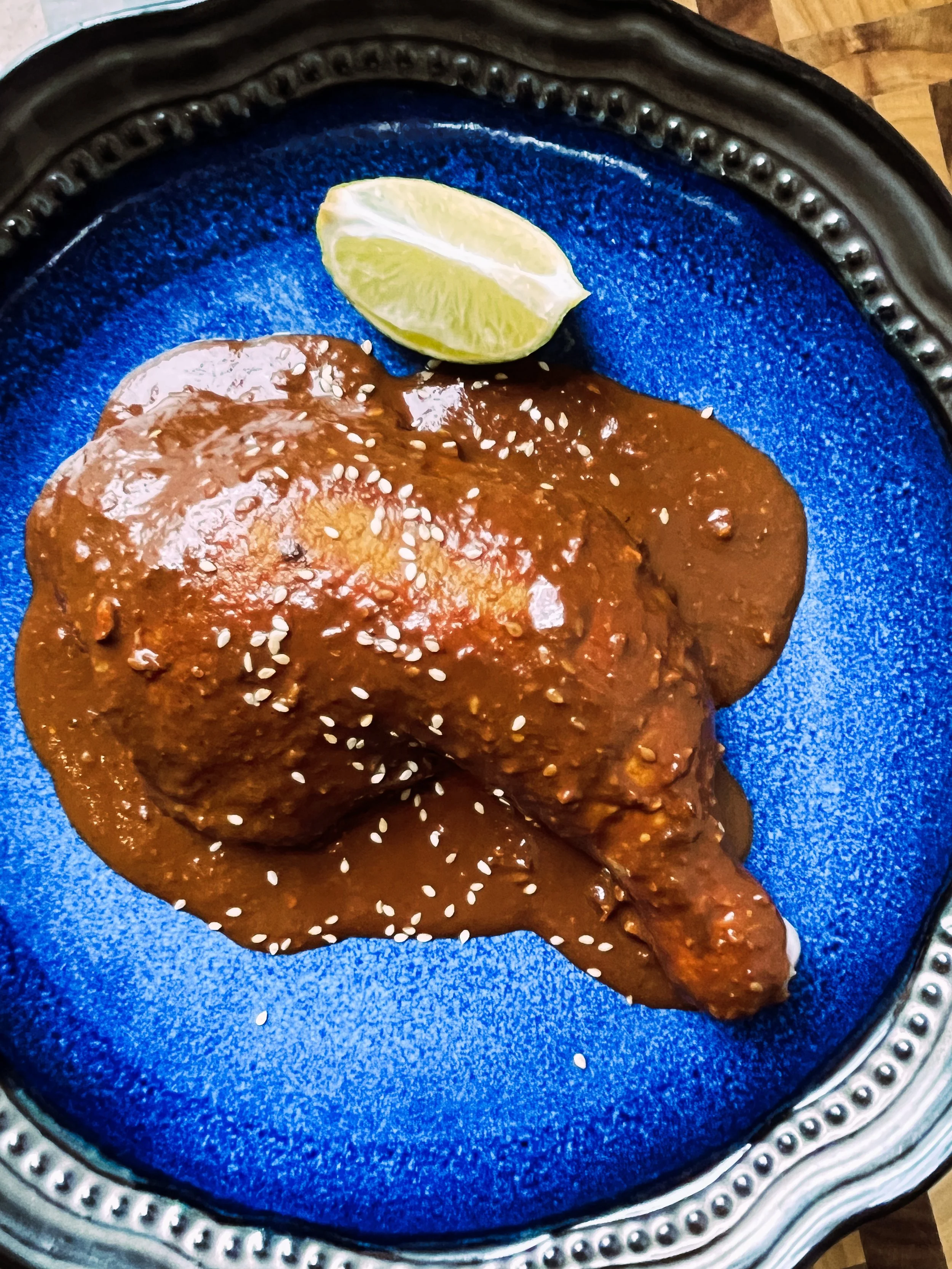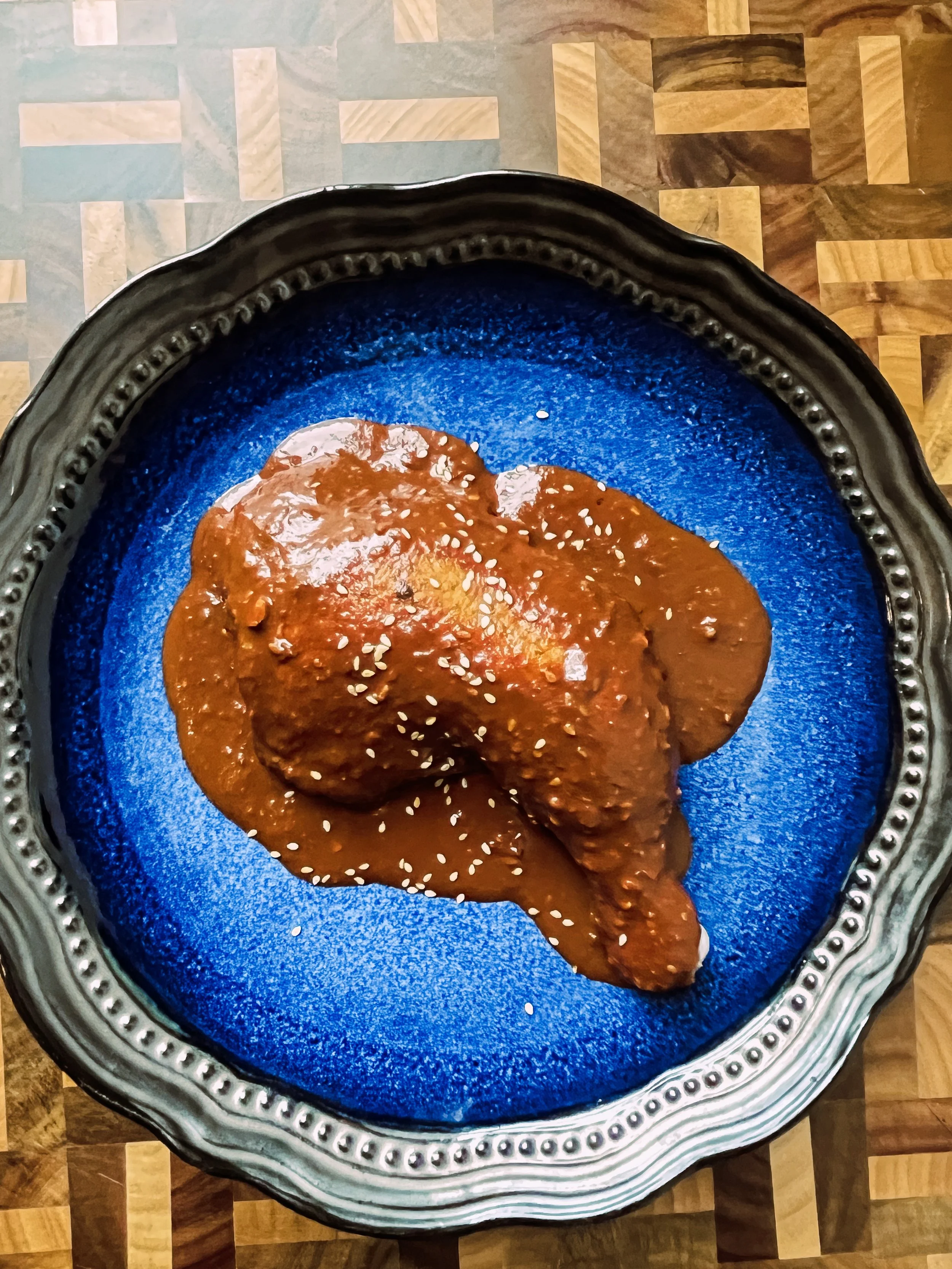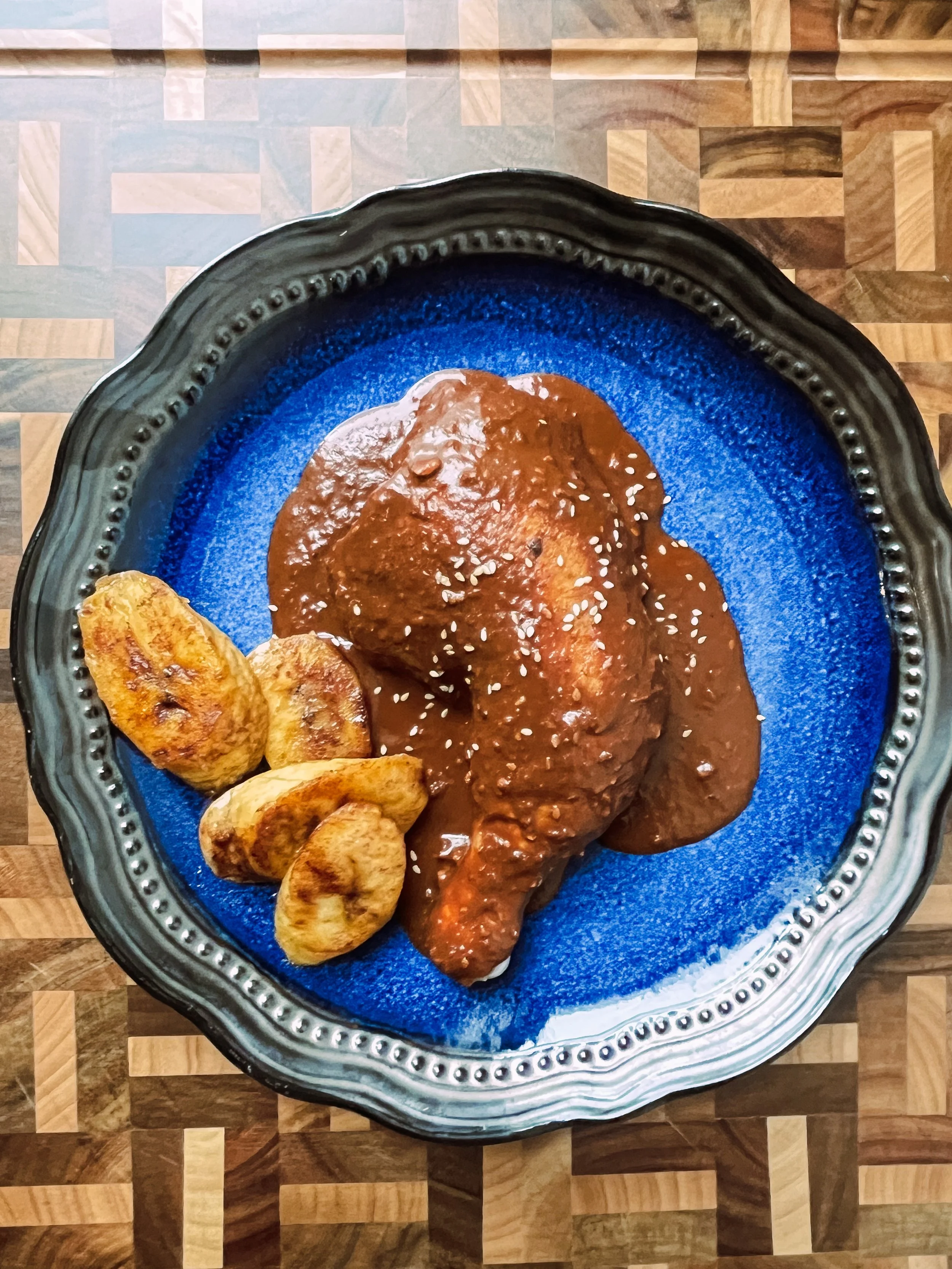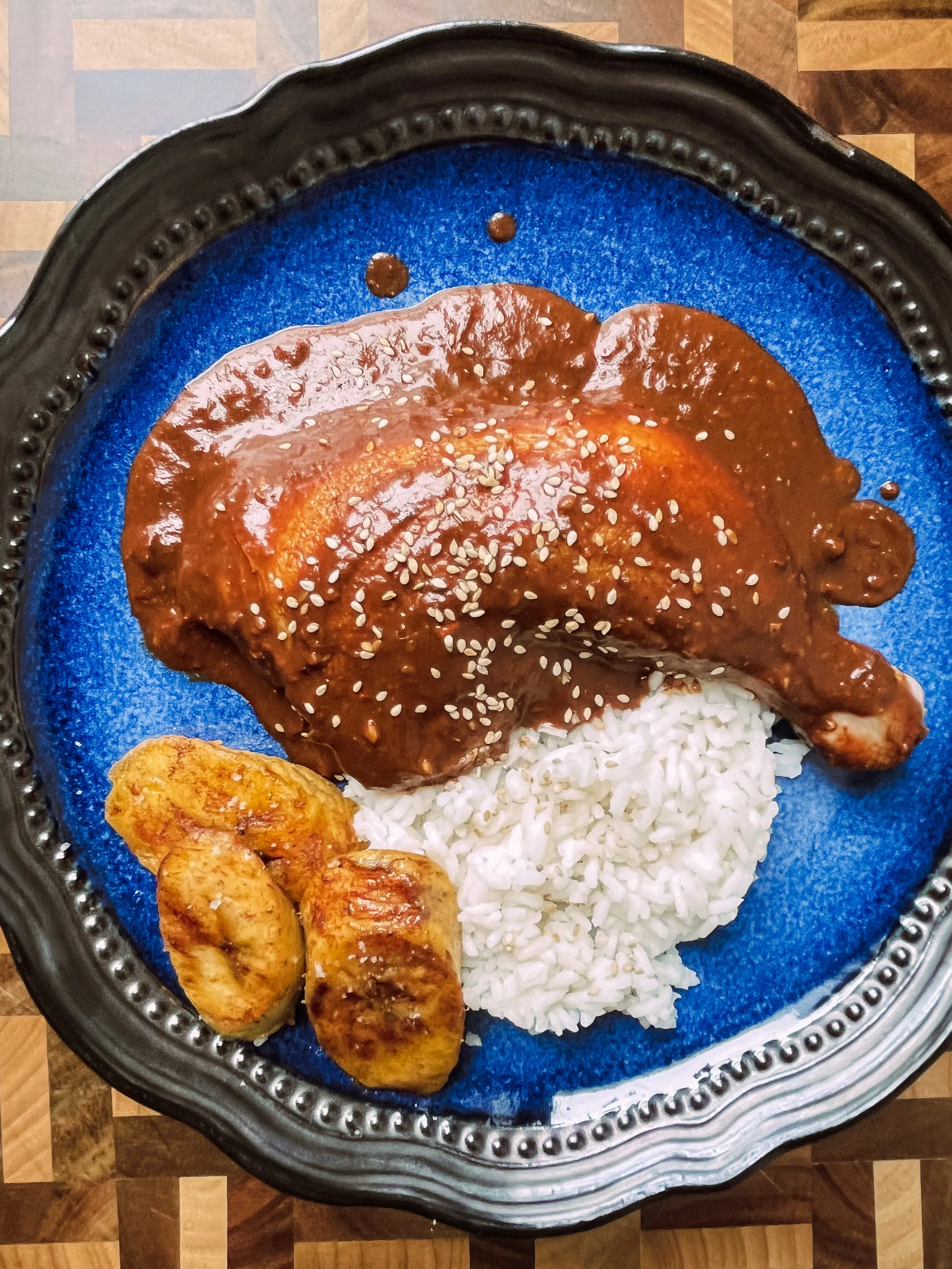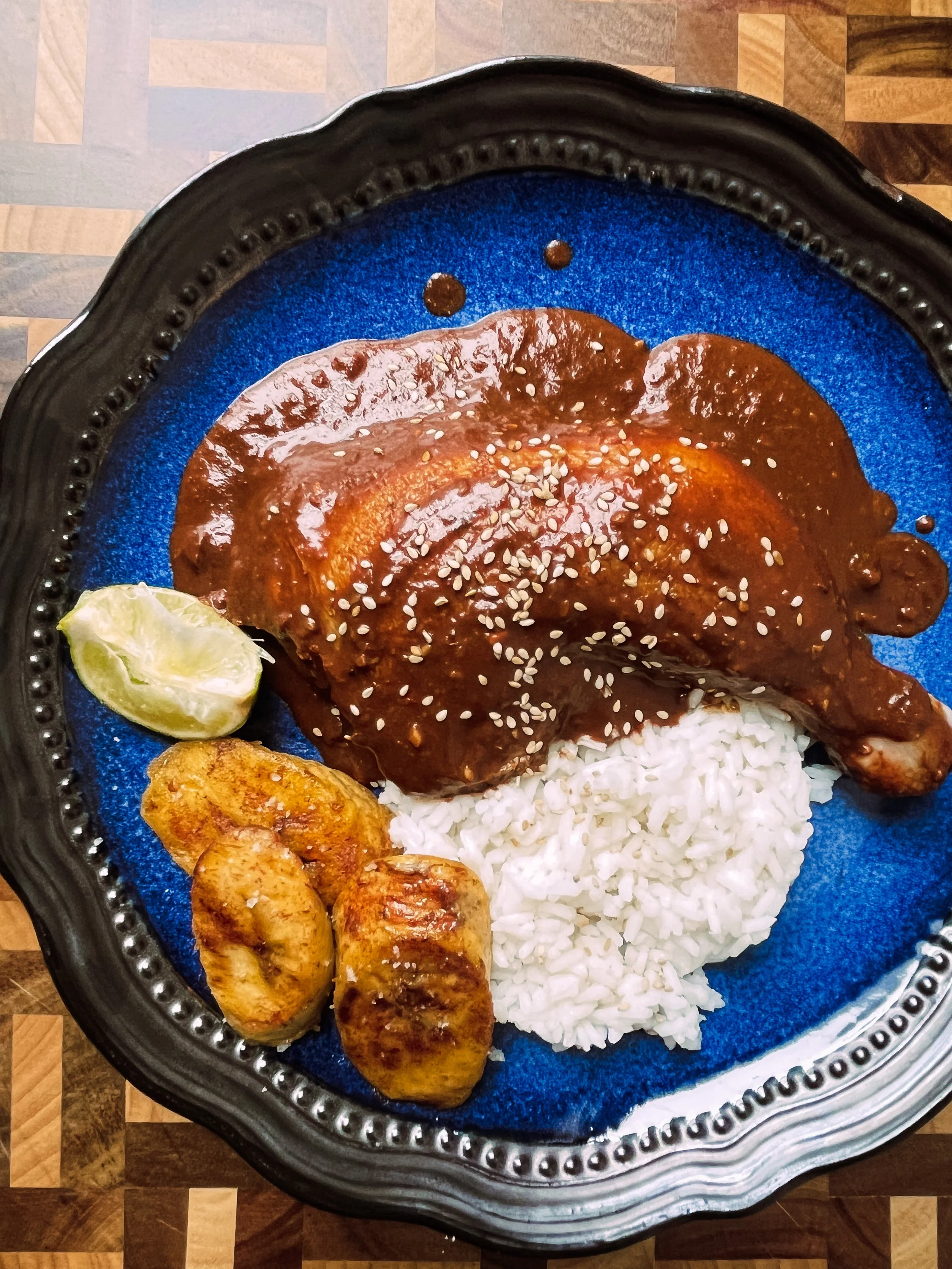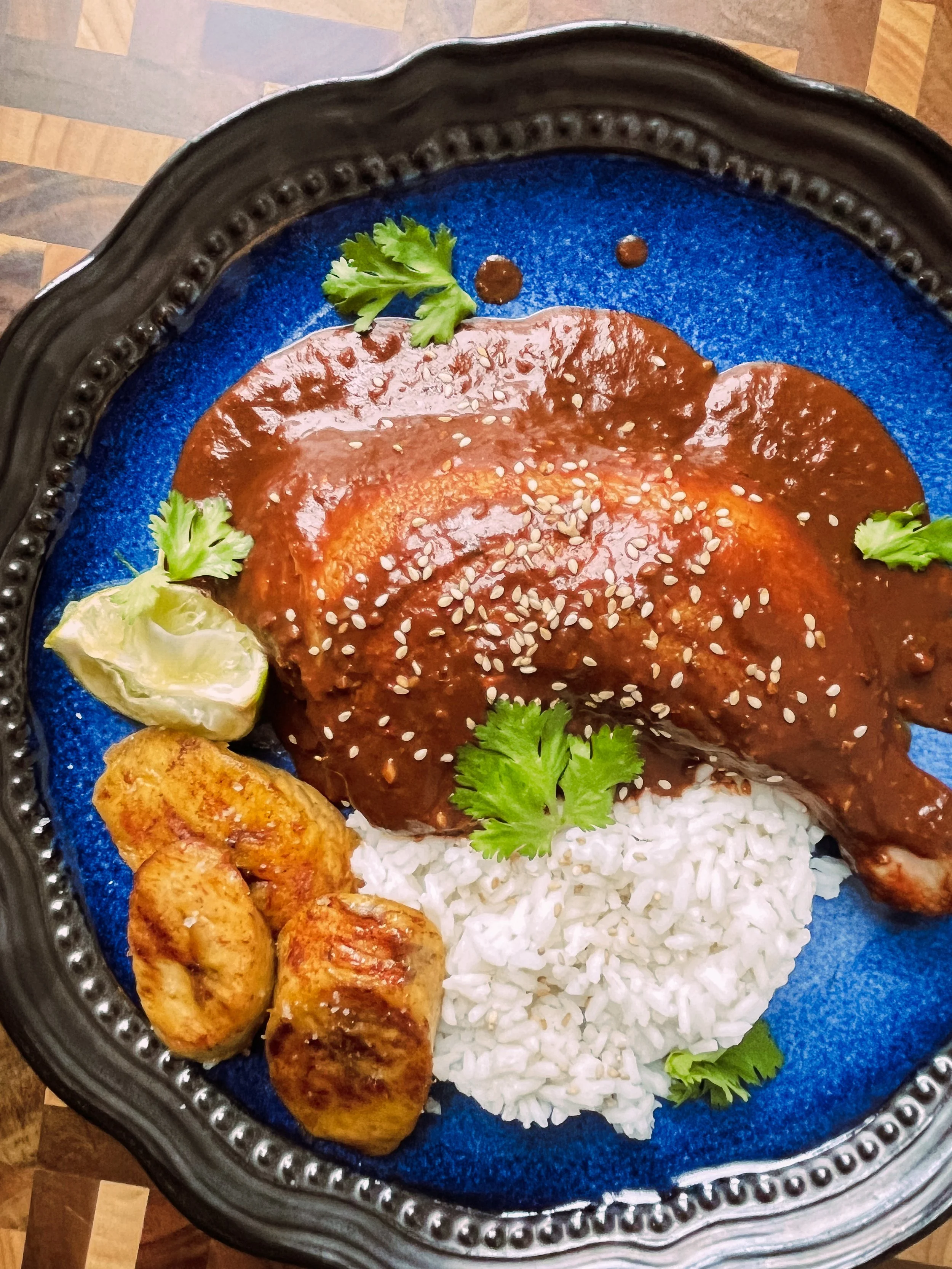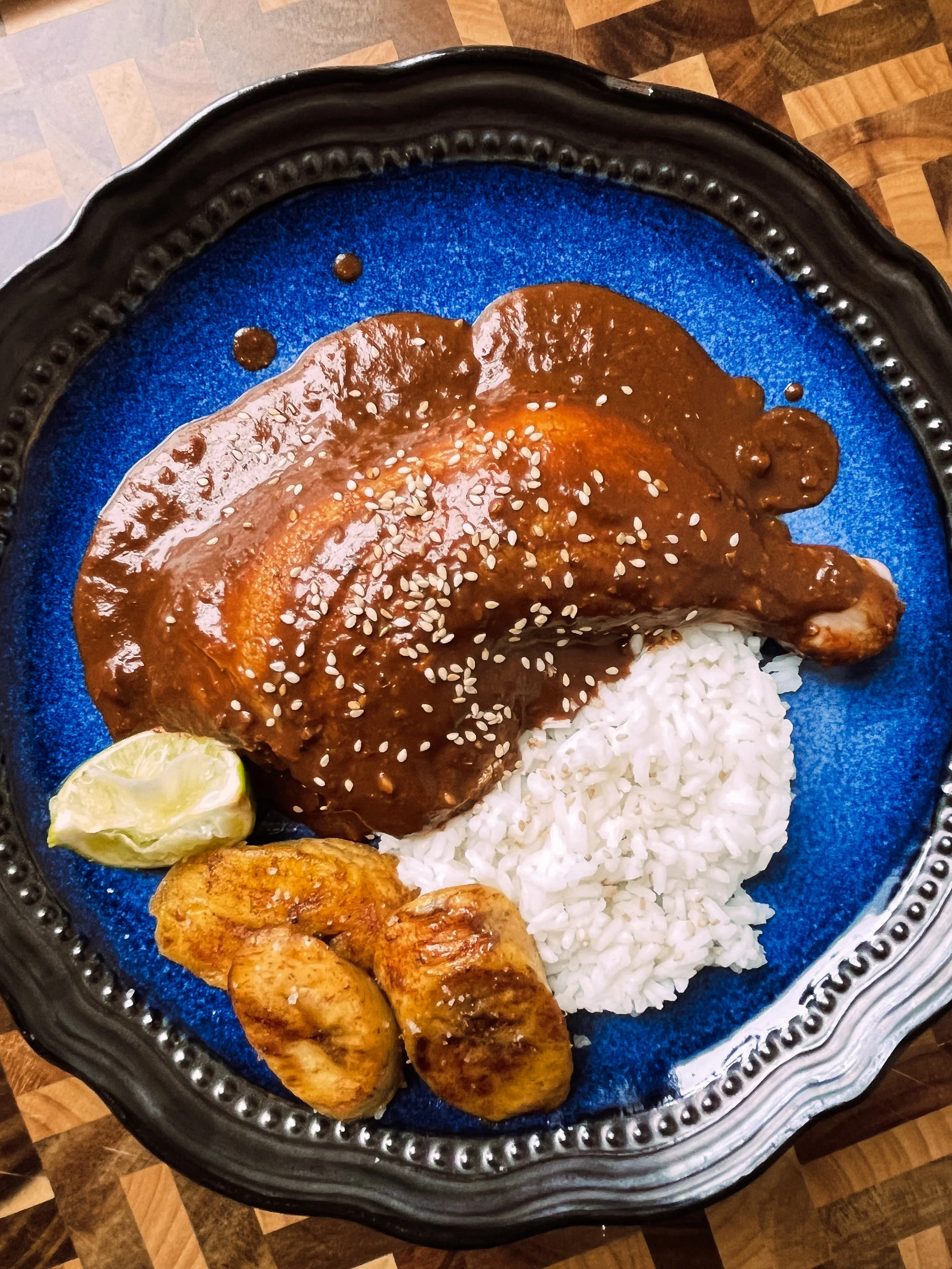Chicken Mole Poblano + Plantains
I moved to New York City in August for culinary school.
On the night before my first day of class, I had a major craving for mole. I went to the market down the street from my apartment, bought all my ingredients (which included asking my local butcher for “one chicken leg, please”), opened a bottle of red wine, and embarked on making mole in a New York City-sized kitchen—which I then enjoyed alone, sitting on my living room floor, watching Julie & Julia in honor of starting school the next morning.
A year ago today I had no idea where I was going to be right now—although I always silently hoped it would be New York. I was beginning my senior year of college and spent the following eight-ish months debating my next move. I went back and forth between culinary school, grad school, or just starting work nearly every single day. I applied to what felt like hundreds of jobs. It got to the point where I would see a reminder for a job interview pop up the day of—about an hour before it took place—and have to go refresh myself on what the role was and who it was for before fixing my makeup from the night before and logging onto Zoom.
Growing up, I always said that I didn’t want to go to culinary school. Not because I didn’t want to go to culinary school, because once again, I always silently hoped I would end up here. I said that because I grew up hearing how you don’t have to go to culinary school to be a great chef. Some chefs even argued that by not going, they were able to become more creative, inventive, and intuitive chefs. I would watch competitors on Chopped who had never been classically trained win, leaving me in an awe of admiration. I thought it was so badass, and I wanted to be that. And I’m stubborn, so I wouldn’t admit that I not only wanted to go to culinary school but that I also need the technical training. I eventually got over this mindset and, even though I didn’t end up doing it then, I looked at going to culinary school straight out of highschool.
Going back to this time last year, I quickly realized that I was under-qualified for every job I wanted. This didn’t stop me from applying, but it definitely showed in the number of responses I received. Every job either wanted a backgorund of culinary school or anywhere from at least 5-10 years in restaurants. If I have one regret, it’s that I didn’t start in kitchens earlier, because at this point my BOH experience totaled up to 3 months as in intern line cook. So, culinary school it was. I am more than happy. And I am more than grateful to be gaining this experience in one of the best food meccas in the world.
So, I moved here in August and I started school about four weeks later. It took a while to move in and get settled before I could break in the kitchen. Technically, the first meal I cooked was a Spanish-inspired brunch for my roommates, but this mole was the second (and much more laborious) dish that I used to christen my new kitchen.
I am not claiming this to be traditional by any means. If anything, it's sort of an “everything but the kitchen sink” version. I drew inspiration from several kinds of mole: the plantains, cinnamon, and brown sugar in mole xacatecano, the chilis and tomatoes in mole poblano and mole queretaro, and the tomatillos from mole verde. For the most part, though, this is a mole poblano. So for the sake of the name, that’s what we’re calling it.
I picked all my favorite things about moles I’ve had in the past and pieced them all together to make this tangy, subtly sweet, rich, fruity, and nutty mole with a sublimely balanced amount of heat and smoke and a glossy finish highlighting pools of cacao butter from the chocolate. The tamarind paste is something that caught my eyes while looking for raisins, and I decided to try it instead. I love the fruitiness and tartness it gives without being overbearingly sweet, like raisins tend to be. I also pan-seared my chicken because I like it with a nice crust and golden-brown color instead of poaching it like in more traditional recipes.
Okay, you know how you’re supposed to read recipes over before starting? I never do that, and I don’t blame you if you don’t either. However, this is one of those times when it truly is for your own good. There are a lot of steps and a lot of ingredients. The final product is so worth it, though, in my biased opinion.
Also, this recipe, just like most sauces, soups, and stews is far better the next day. Feel free to make this a day or two advance, or even earlier in the day, and just follow the steps that involve finishing the chicken in the sauce when ready to serve. Otherwise, there will definitely be leftover sauce with this recipe that you can smother over pretty much anything the next day: eggs, leftover rice and plantains, tacos, enchiladas, etc. etc. etc.
Chicken with Mole Poblano and Fried Plantains
Serves 4 (with extra sauce)
Prep time: 20 minutes, Cook time: 60+ minutes
For the sauce:
2 dried ancho chilis
2 dried guajillo chilis
1/3 cup aji panca paste
1/4 cup each: white sesame seeds, dry roasted peanuts, blanched almonds
2 packed tbs. tamarind paste (can sub for 1/4 cup packed dried raisins + juice from 1 lime)
6 plum tomatoes
3 tomatillos
1/2 large sweet onion
4 garlic cloves
1/2 large plantain, halved once again lengthwise
1 pan sabao roll or bolilo roll (can sub for 1-2 corn tortillas or 1 slice of dense white bread)
1 tbs. brown sugar
1/4 cup fresh cilantro
1 tbs. Better Than Bouillon Chicken or 3 cubes chicken bouillon
1 tbs. dried Mexican oregano
3 tsp. ground cumin
1 tsp. ground cinnamon
2 bay leaves
2 tsp. salt (more or less to taste)
1 tsp. black pepper (more or less to taste)
2 oz. Mexican chocolate or any dark chocolate above 85%
Olive oil or lard — will use throughout most steps of cooking
Garnishes: additional fresh cilantro, lime juice, and cotija cheese
For the chicken:
One whole chicken, or at least 2 legs and 2 breasts
2 tsp. ground cumin
1 tbs. salt
1/2 tbs. black pepper
Light olive oil or lard, for cooking
For the plantains:
1.5 plantains (using the remaining half from the Mole sauce)
Oil of choice - I used a light olive oil — coconut or peanut oil will work if you don’t mind the added flavor, or use canola or sunflower oil if you want a more neutral flavor
1/2 tsp. ground cinnamon
Flakey salt
For the rice:
2 cups long-grain white rice
1 bay leaf
pinch salt
Preheat the oven to 425ºF. Remove the stems and wash the stickiness off of the tomatillos. Slice the tomatoes, tomatillos, and half of the onion in half. Spread them, along with the peeled garlic cloves, on a sheet tray with a light drizzle of olive oil and a pinch of salt. Roast until tender and slightly charred, about 20 minutes, tossing halfway through. Let cool to handle.
While those are cooking, heat a small saucepan over medium-high heat. Slice open the dried chilies and lightly rinse them to remove dirt or dust, leaving the seeds if you prefer it spicy. Pat the peppers dry, add 1/2 tbs. oil or lard to the pan once heated along with the peppers. Cook until fragrant, just a few minutes, before pouring 3 cups of water into the hot saucepan. Reduce to a low heat and cook until the peppers are rehydrated and the water is a deep translucent red color, about 15 minutes. Cool to a lukewarm temperature.
Meanwhile, in a large pot (one you will use to cook the sauce), begin to fry everything seperately in a couple tablespoons of oil/lard: the sesame seeds, the peanuts and almonds, the bread roll, and half of the plantain until everything is lightly golden brown and fragrant. Do not use any burned pieces or the mole will taste bitter. Keep the finished nuts separate from the plantains and roll.
Pat the chicken dry and season with cumin, salt, and pepper, evenly covering all areas of the chicken. In the same pot, add more oil and brown the chicken over medium-high heat until cooked 75% of the way (about an internal temp of 125ºF) and crispy on both sides. Depending on each piece size this could take around 3-4 min per side. Deglaze the pan with the reserved pepper water.
In a blender (in batches if needed), add the peppers, tomatoes, tomatillos, onions, garlic, fresh cilantro, tamarind paste, fried plantain and roll, and liquid from the peppers. Blend until completely smooth. Add in the nuts and sesame seeds and pulse until there are no large nut pieces but it still has a gritty texture.*
Pour the sauce back into the pot, add in the spices, aji panca paste, chicken bouillon, chocolate, and bay leaves. Simmer uncovered for about 10 minutes. If the sauce is too thick, add more water or chicken/vegetable stock to loosen it up 1/4 cup at a time. It should be a consistency similar to an Italian red sauce. Add more aji panca paste, salt, chocolate, or spices to taste as needed.
While simmering, bring 4 cups of water and the rinsed rice to a boil in another pot. Add in a bay leaf, pinch of salt, reduce to low heat, and cover for about 20 minutes, or until the water is completely absorbed. Fluff up the rice with a fork and remove the bay leaf. Set aside to serve.
After the rice is finished cooking, complete the final steps of the sauce. Remove the bay leaves, add in the partially cooked chicken, cover, and continue cooking until the chicken reaches an internal temperature of 160ºF (about 10-15 minutes). Uncover, turn off the heat, and let sit for another 5 mniutes before serving.
While the chicken is cooking, heat oil for the plantains in a fry pan — just enough to cover the bottom of the pan, not enough to add depth. Fry the plantains over medium-high heat until golden brown on both sides. Move to a towel-lined dish to absorb excess oil and immediatley dust lightly with cinnamon and a sprinkle of salt.
Serve the chicken and mole sauce over rice with plantains on the side (or with sauce, as well). Garnish with fresh cilantro, lime juice, and a sprinkle of cotija cheese.
*If you prefer a completely smooth sauce, feel free to blend it all the way to make it smooth. I just prefer a more textured sauce.

